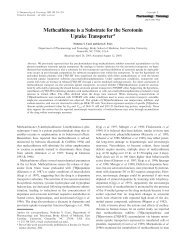STATEMENT OF NICHOLAS V
STATEMENT OF NICHOLAS V
STATEMENT OF NICHOLAS V
Create successful ePaper yourself
Turn your PDF publications into a flip-book with our unique Google optimized e-Paper software.
18. Dr. Frankenheim assumes as a "given" that users of Daime seek a "psychosis-like" effect. (Section II.<br />
5.) Dr. Frankenheim repeatedly refers to the psychological states induced by hallucinogens in<br />
pejorative language such as "psychotomimetic", "psychosis-like", "mental distortions", etc. These<br />
terms all have a negative, pathological flavor and Dr. Frankenheim implies that the state induced by<br />
Daime is itself negative or pathological. These statements and similar ones in his declaration belie his<br />
understanding of Daime use; in reality, sacramental users of Daime seek spiritual or religious<br />
fulfillment, not psychosis.<br />
19. The term "psychotomimetic" was coined in the 1950s when the pharmacological distinctions among<br />
psychoactive compounds that disrupted normal, waking consciousness in a variety of ways were not<br />
well-understood. The term "psychotomimetic" was indiscriminately applied to various drugs such as<br />
LSD, anesthetic agents such as phencyclidine (PCP) and ketamine, and anticholinergic agents such as<br />
quinuclidinyl benzilate. As our understanding of psychoactive drug effects has progressed over the<br />
last 50 years, the limitations of the term "psychotomimetic" have become apparent and the term is<br />
now reserved to describe states of consciousness produced by PCP or high-dose or chronic cocaine<br />
and amphetamine use. It is now widely-accepted among neuroscientists, psychopharmacologists,<br />
psychiatrists, and other medical professionals that hallucinogens do not produce a "psychotomimetic"<br />
state. Rather, the latest scientific evidence is that these compounds produce a beneficent state with<br />
sustained positive changes in attitudes and behavior (Griffiths et al., 2006; Griffiths et al., 2008). The<br />
state has been described as a mystical or religious experience, not a "psychosis" (Griffiths et al., 2006;<br />
Griffiths et al., 2008). According to reports from Daime users, this is precisely what is achieved.<br />
20. In section II. 11. a. i., referring to Daime given to volunteers (Riba et al., 2003), Dr. Frankenheim<br />
states that "Diastolic blood pressure showed a significant increase. . ." While both diastolic and<br />
systolic pressures are important, systolic pressure, not diastolic pressure, is a stronger predictor of<br />
negative health consequences such as coronary heart disease, stroke, and end-stage renal disease (He<br />
and Whelton, 1999a; He and Whelton, 1999b). Dr. Frankenheim's statement is misleading on another<br />
level: "significant" in the context of the study refers to statistical significance, not physiological<br />
significance. The highest actual increase in diastolic blood pressure observed in this study (at one<br />
time point) was 9 mm Hg. The elevation was more typically only 3-5 mm Hg throughout the 4 hour<br />
observation period (Riba et al., 2003). These small increases in diastolic blood pressure are of<br />
absolutely no physiological consequence; notably, all of the measured pressures were within the<br />
optimal values of blood pressure as determined by the Joint National Committee on Prevention,<br />
Detection, Evaluation, and Treatment of High Blood Pressure (Chobanian et al., 2003). Furthermore,<br />
no changes were observed in two other parameters (systolic blood pressure and heart rate) of greater<br />
physiological importance in the study cited. In an earlier study by the same group, no statistically or<br />
clinically relevant changes were observed in any cardiovascular parameters whatsoever (Riba et al.,<br />
2001b).<br />
21. Dr. Frankenheim states that "it is possible to predict the toxicology of ayahuasca based on scientific<br />
evidence about its active components". However, Dr. Frankenheim makes no such prediction, later<br />
stating that a risk/benefit analysis "is not feasible at this time" because benefits have not been<br />
recognized by the FDA or the medical community at large. (Section II. 8.) This position implies that<br />
the only benefits to be considered in a risk/benefit analysis are those recognized by the FDA or<br />
medical professionals. But many drugs are legally and beneficially used outside of medical settings.<br />
Examples include the drinking of tea (containing the drug theophylline) for pleasure or relaxation, the<br />
consumption of peyote (containing the drug mescaline) for religious purposes, the consumption of<br />
beer (containing the drug alcohol) for pleasure or inebriation, etc.<br />
22. Dr. Frankenheim states that "Generally, toxicity of drugs is determined by statistically estimating the<br />
acute dose that kills 50% of the laboratory animal subjects, the LD50 (median lethal dose)". Dr.



